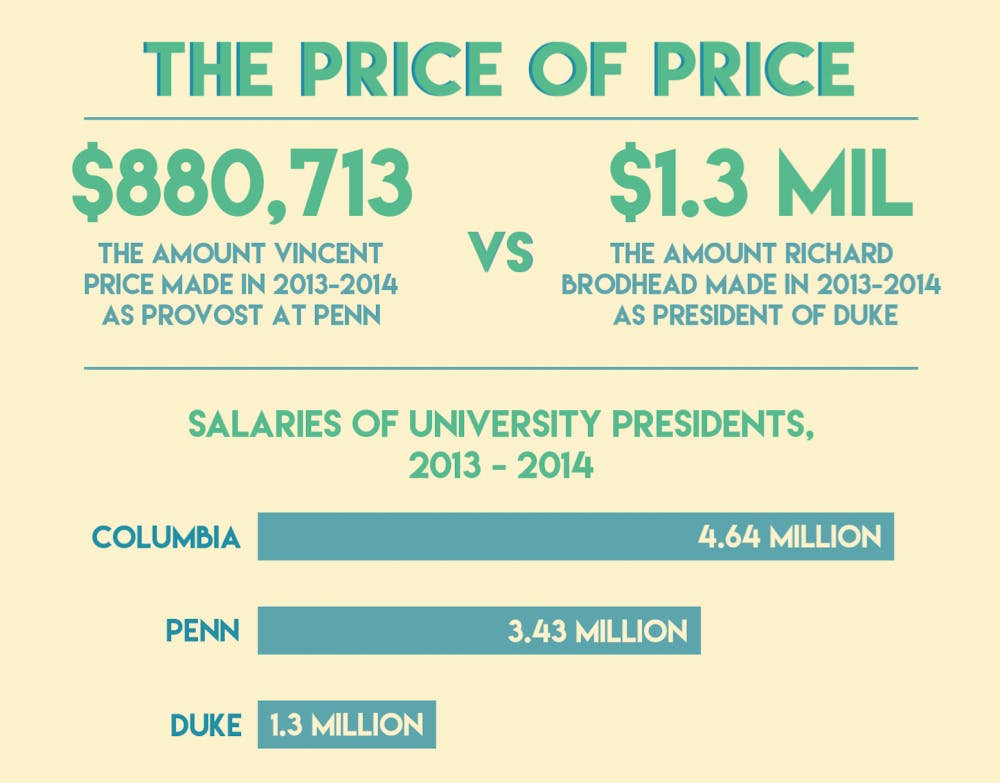Vincent Price’s large paycheck will likely get even larger when he starts his term as president next year.
Duke’s next president is currently the provost at the University of Pennsylvania, where he is one of the highest paid provosts at elite private universities nationwide, according to The Chronicle’s analysis of records filed with the Internal Revenue Service. It’s likely that Price’s upgraded title at Duke will come with an improved pay package. As a result, Price could be paid even more than he is in Philadelphia when he arrives in Durham.
"We don’t discuss compensation," said Michael Schoenfeld, vice president for public affairs and government relations. "In general, and we’ve said this before, the University and the Board seek to be competitive with the marketplace and have compensation that will attract and retain the best talent."
John Burness, visiting professor of the practice in the Sanford School of Public Policy and former senior vice president for public government affairs and public relations, explained that University officials' compensations are set by the Board of Trustees based on outside evaluations of compensation for similar positions.
“One would assume that in the case of the president they would take a look at what compensation is for presidents at like-minded institutions and somewhere within that range would be how it would be determined," he said. "That’s how traditionally it has been done.”
President Richard Brodhead’s total compensation from the University was $1.3 million in 2013-14, more than double the $500,000 he made during his first year at Duke. However, Brodhead’s seven-figure payday was actually below average among a group of 10 private peer institutions, according to The Chronicle’s analysis. The highest paid university president among this group was Columbia University’s Lee Bollinger, who took home a grand total of $4.64 million in 2013-14. Number two on the list was the University of Pennsylvania’s Amy Gutmann, whose total compensation during the same period was $3.43 million.
The University of Pennsylvania apparently favors paying its officials well, since Price also receives a paycheck that is above his peers. In 2013-14, he made a total of $880,713, more than any other provost at an elite private research institution in Duke’s peer group.
In fact, Price’s current total compensation is greater than that of several university presidents in the same group, The Chronicle’s analysis found. Peter Salovey, president of Yale University, and Christopher Eisgruber, president of Princeton University, both took home less total compensation in 2013-14 than Price did as provost at Penn. Peter Lange, who was Duke’s provost in 2013-14, earned a total of $639,929 during that time period.
When Price is inaugurated as Duke’s president, his pay will probably be more than it is in his current position.
“The president would likely be paid more than a provost, let’s put it that way,” Burness said.
Price may earn less than what Brodhead currently makes, however. The Chronicle’s analysis found that new university presidents in Duke’s peer group on average make 12 percent less during their first year in office than their predecessors did during their last year in office. All of the new presidents in Duke’s peer group who took office after 2010 made more than 20 percent less in their first year than their predecessors did before leaving.
When Richard Brodhead began his term at Duke in 2004, he made about 2 percent less than Nannerl Keohane, Duke’s previous president, did during her last year at the University.
Burness noted, however, that pay is rarely a key factor in whether a university recruits a particular candidate as president.
“Having watched several presidential searches at different institutions over time, the compensation is very rarely a big issue,” he said. “The issue is whether they find the right fit and does the person they’ve selected want the job. The compensation sort of sorts itself out. It’s not variable number one, it might be variable number four.”
Get The Chronicle straight to your inbox
Signup for our weekly newsletter. Cancel at any time.

